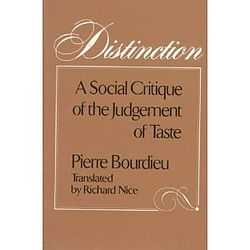La Distinction
| La Distinction | |
|---|---|
 English cover | |
| Author | Pierre Bourdieu |
| Language | French |
| Subject | Sociology |
La Distinction (1979), by Pierre Bourdieu, is a sociological report about the state of French culture, based upon the author’s empirical research, from 1963 until 1968. In the US, the book was published as Distinction: A Social Critique of the Judgement of Taste (1984). In 1998 the International Sociological Association voted La Distinction as one of the ten most important books of sociology of the 20th century.[1]
Summary
In La Distinction (1979), the sociologist Pierre Bourdieu proposed that the powers that be of a society define aesthetic concepts such as taste; and by means of that definition, it is social class that tends to determine a person’s interests, likes, and dislikes, and how such social distinctions, based upon social class, are reinforced in daily life. Indeed, he argues that 'art and cultural consumption are predisposed, consciously and deliberately or not, to fulfil a social function of legitimating social differences.'[2] Moreover, that even when the subordinate social classes might seem to have their own ideas about what is and what is not good taste, “the working-class ‘aesthetic’ is a dominated aesthetic, which is constantly obliged to define itself in terms of the dominant aesthetics” of the ruling class.[3]
Theory
The aesthetic choices of a person create class fractions (class-based social groups) and actively distance one social class from the other social classes of a society. Hence, predispositions to certain kinds of food, music, and art are taught and instilled to children, which specific tastes then guide the children to their appropriate social positions. Therefore, self-selection to a class fraction is achieved by impelling the child’s internalization of preferences for objects and behaviors suitable for him or her (as member of a given social class), and the development of an aversion towards the preferred objects and behaviors of the other social classes. In practice, when a man or a woman encounters the culture and the arts of another social class, he or she feels “disgust, provoked by horror, or visceral intolerance (‘feeling sick’) of the tastes of others.”[4]
Therefore, “Taste” is an important example of cultural hegemony, of how class fractions are determined, not only by the possession of social capital and of economic capital, but by the possession of cultural capital, which is an insidious social mechanism that ensures the social reproduction and the cultural reproduction of the ruling class. Moreover, because a person is taught his or her tastes at an early age, and thus are deeply internalized, such social conditionings are very difficult to change, and thus tend to permanently identify a person as having originated in a certain social class, which then impedes upward social mobility. In that way, the cultural tastes of the dominant (ruling) class tend to dominate the tastes of the other social classes, thus forcing individual men and women of economically and culturally dominated classes to conform to certain aesthetic preferences, lest they risk societal disapproval by appearing to be crude, vulgar, and tasteless persons.
Methodology
Influenced by structuralism, Bourdieu sought to go beyond the traditional reliance on regression analysis in contemporary sociology and achieve a more rigorous quantitative approach. Rather than relying on the correlation of multiple independent variables, he was interested in developing a framework to allow him to view "'the complete system of relations that make up the true principle of the force and form specific to the effects recorded in such and such correlation.'" For the analysis in La Distinction, Bourdieu, working with his statistical technician Salah Bouhedja, employed multiple rounds of correspondence analysis on a set of data from two surveys, the "Kodak survey" of 1963 and the "taste survey" of 1967. In addition to this analysis, Bourdieu also applied correspondence analysis to a subset of the data, the responses from what Bourdieu labelled the "dominant classes" and the "petite-bourgeoisie." This type of research represented an early attempt at geometric data analysis, specifically multiple correspondence analysis, which would become an important methodological framework in Bourdieu's later work.[5]
Notes
- ↑ "ISA - International Sociological Association: Books of the Century". International Sociological Association. 1998. Retrieved 2012-07-25.
- ↑ Bourdieu, Pierre (1984). Distinction. Routledge. p. 7. ISBN 0-674-21277-0.
- ↑ Bourdieu, Pierre (1984). Distinction. Routledge. p. 41. ISBN 0-674-21277-0.
- ↑ Distinction, Bourdieu 1984 p 56
- ↑ Karen Robson; Chris Sanders (21 January 2009). Quantifying Theory: Pierre Bourdieu: Pierre Bourdieu. Springer. pp. 12–14. ISBN 978-1-4020-9450-7.